The hot desert is a land of extremes: extreme heat and extreme dryness; sudden flash floods and cold nights. Because deserts are such a harsh environment, deserts often have names likes "Death Valley," "the empty quarter," and "the place from where there is no return."
Dryness
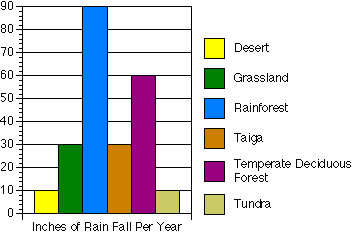 Deserts are usually very, very dry. Even the wettest deserts get less than ten inches of precipitation a year.
Deserts are usually very, very dry. Even the wettest deserts get less than ten inches of precipitation a year. In most places, rain falls steadily throughout the year. But in the desert, there may be only a few periods of rains per year with a lot of time between rains. When it does rain, there may be quite a downpour! After the rain, desert flowers bloom.
Hot During the Day, Cool at Night
Everyone knows that during the day many deserts are hot, very hot. Temperatures in excess of 100 degrees fahrenheit are not uncommon. Yet at night, the same deserts can have temperatures fall into the 40s or 50s? Why?
Other biomes are insulated by their humidity (water vapor in the air). Temperate deciduous forests, for example, may have 80 percent humidity or more during the day. This water reflects and absorbs sunlight and the energy it brings. At night the water acts like a blanket, trapping heat inside the forest.
Since deserts usually have only between 10 and 20 percent humidity to trap temperatures and have so few trees and other vegetation to retain heat, they cool down rapidly when the sun sets, and heat up quickly after the sun rises.
Types of Deserts Believe it or not, deserts come in several varieties. The two major classifications are hot and cold. Most of the information in this web site pertains to hot deserts.
Hot Deserts of the World
The main form of precipitation in a hot desert is rain. But that's only ten inches or less of rain per year.
| Hot Deserts of the World | |||||
| Name Location | Size | Physical Features | Some Plants & Animals | Special Facts | |
| Arabian Arabian Peninsula | 900,000 mi2 | Covered almost entirely by sand; has some of the most extensive stretches of sand dunes in the world. | acacia, oleander, saltbush desert locust, dromedary camel, gazelle, lizard, jackal, oryx | Nomadic Bedouin tribes have travelled through the Arabian Desert for thousands of years. | |
| Australian (Great Sandy, Victoria, Simpson, Gibson, and Sturt) Australia | 890,00 mi2 (1/3 of Australia) | Great Sandy, Victoria, and Simpson are sandy; Gibson and Sturt are stony. | acacia, casuarina tree, eucalyptus, saltbush, spinifex grass blue-tongued lizard, dingo, fat-tailed mouse, kangaroo, marsupial mole, rabbit-eared bandicoot, sand goanna, spinifex hopping mouse, throny devil | Aborigines have lived in the Australian deserts for over 30,000 years. | |
| Chihuahuan North Central Mexico and Southwestern United States (Arizona, New Mexico, Texas) | 175,000 mi2 455,000 km2 | High plateau covered by stony areas and sandy soil. Many mountains and mesas. | cacti, chihuahuan flax, creosote bush, lechuguilla, mesquite, mexican gold poppy coyote, diamondback rattlesnake, javelina, kangaroo rat, roadrunner | Largest North American desert. Big Bend National Park located here; more species of birds seen in Big Bend than in any other National Park in the U.S. | |
| Kalahari Southwestern Africa | 200,000 mi2 520,000 km2 | Covered by sand dunes and gravel plains. | acacia, aloe gazelle, gerbil, ground squirrel, hyena, jackel, sandgrouse, springbok | Bushman have lived in the Kalahari for 20,000 years. | |
| Mojave Southwestern United States (Arizona, California, Nevada) | 25,000 mi2 65,000 km2 | Covered by sandy soil, gravelly pavement, and salt flats. | creosote bush, desert sand verbena, joshua tree, mesquite bighorn sheep, chuckwalla, coyote, jackrabbit, sidewinder, zebra-tailed lizard | Death Valley located in this desert. | |
| Monte Argentina | 125,000 mi2 325,000 km2 | Covered by sand and soil | cardon cactus, creosote bush, paloverde armadillo, cavy, jaguarundi, puma, tinamou, tuco-tuco | Very similar to the Sonoran Desert | |
| Sahara Northern Africa | Covered by mountains, rocky areas, gravel plains, salt flats, huge areas of dunes. Areas in the central sometimes get no rain for years at a time. | acacia, grasses, tamarisks addax antelope, dorcas gazelle, fennec fox, horned viper, jackal, jerboa, sandgrouse, spiny-yailed lizard | Largest desert in the world. Fewer than 2 million inhabitants (mostly nomads such as the Tuareg). Crossed by Arab caravans since the 10th century. | ||
| Sonoran Southwestern United States (Arizona, California) and parts of Mexico (Baja Peninsula, Sonora) | 120,000 mi2 312,000 km2 | Covered by sand, soil, and gravelly pavement. Gets more rain than any other North American desert. | agave, coulter's globemallow, creosote bush, desert mariposa lily, mesquite, ocotillo, paloverde, saguaro coati, elf owl, gila monster, kangaroo rat, pack rat, roadrunner, sidewinder, tarantula | Most complex animal-plant community of any desert. One of the most beautiful deserts in the world. | |
| Thar India and Pakistan | 77,000 mi2 200,000 km2 | Majority of desert covered by sand dunes; rest covered by gravel plains | acacia, euphorbias, grasses, shrubs black buck, dromedary camel, great Indian bustard, Indian spiny-tailed lizard, jackel, sandgrouse | ||
Cold Deserts of the World
The main form of precipitation in a cold desert is snow or fog.
| | |||||
| Name Location | Size | Physical Features | Some Plants & Animals | Special Facts | |
| Atacama Coasts of Peru and Chile | 54,000 mi2 140,000 km2 | Covered by sand dunes and pebbles. One of the driest areas on earth. | bunchgrass, cardon cactus, tamaruga trees lizards, llama, Peruvian fox, nesting area for many seabirds | Only a few thousand people (mostly farmers) live in the inland desert areas. Large deposits of sodium nitrate are found in the desert. Sodium nitrate is used to make gunpowder. | |
| Gobi Northern China and Southern Mongolia | 450,000 mi2 1,200,000 km2 | Covered by sandy soil and areas of small stones called "gobi." | camel's thorn, grasses bactrian bamel, gazelle, gerbil, jerboa, lizards, onager, wolf | Crossed by Genghis Khan in the early 13th century. Many nomads now settling on government-run farms. | |
| Great Basin Western United States (Idaho, Nevada, Oregon, and Utah) | 158,000 mi2 411,000 km2 | Covered by sand, gravel, and clay. Many moutains ranges, basins, and large expanses of salt flats. | greasewood, sagebrush, shadscale bighorn sheep, jackrabbit, pocket mouse, poor-will, pronghorn antelope, sage thrasher, side-blotched lizard | Great Salt Lake located here. | |
| Iranian Iran, Afghanistan, and Pakistan | 150,000 mi2 390,000 km2 | Covered by coarse gray soil, stony pavement, and salt flats. | grasses, pistachio trees, shrubs monitor lizard, onager, oryx, scorpion | World's largest salt flat located here. | |
| Namib Coasts of Southwestern Africa | 52,000 mi2 135,000 km2 | Covered by sand dunes along the coast and gravel farther inland. | aloe, bunchgrass, lichens, welwitschia darkling beetle, fringe-toed lizard, golden mole, jackal, sidewinder, viper, web-footed gecko | Coast of the Namib Desert is world's greatest source of gemstones. | |
| Takla Makan Western China | 600,000 mi2 | Covered by sand dunes and rocky soil. | grasses, shrubs bactrian camel, jerboa, long-eared hedgehog, gazelle | The word "Takla Makan" means "place from which there is no return." Crossed by Marco Polo in the 13th Century. | |
| Turkestan Parts of the Middle East and Southwestern Russia | 215,000 mi2 559,000 km2 | Covered mostly by extensive stretches of sand dunes. | alhagi shrub, saxaul tree, sedges, thick ground cover desert tortoise, gazelle, gerbil, saiga antelope | Crossed by caravans following silk route from China in Europe in ancient times. The great city of Samarkand, once a cultural and religious center of central Asia, was located here. | |
Where Are Deserts Located?

Some deserts located by mountains and are caused by the "rainshadow" effect. As air moves up over a mountain range, it gets cold and loses the ability to hold moisture -- so it rains or snows. When the air moves down the other side of the mountain, it gets warmer. Warm air can hold lots of moisture, so it doesn't rain as much, and a desert is formed.

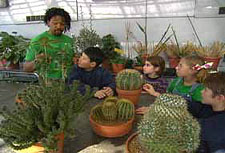 Deserts are the home to many living things. In fact, deserts are second only to tropical rainforests in the variety of plant and animal species that live there. How do you think plants grow in a place that is very, very dry?
Deserts are the home to many living things. In fact, deserts are second only to tropical rainforests in the variety of plant and animal species that live there. How do you think plants grow in a place that is very, very dry? Many of the fascinating features of desert plants are adaptations -- traits that help the plant survive in its harsh environment. Desert plants have two main adaptations:
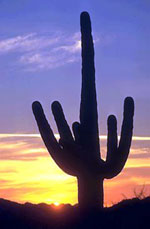 The stem of the Saguaro Cactus stores all of its water. The stem is green. Photosynthesis occurs in the top layer of the stem instead of in leaves. This plant has another adaptation that is hidden from us. This is its large net of roots -- that extend far away from its trunk. How would these roots help a desert plant? The roots collect water after rain. Stored in the pleated expandable stem, the water keeps the saguaro alive until the next rain. Saguaro fruit is used in jam and woody skeletons are used in building materials. The Saguaro only grows in the Sonoran Desert.
The stem of the Saguaro Cactus stores all of its water. The stem is green. Photosynthesis occurs in the top layer of the stem instead of in leaves. This plant has another adaptation that is hidden from us. This is its large net of roots -- that extend far away from its trunk. How would these roots help a desert plant? The roots collect water after rain. Stored in the pleated expandable stem, the water keeps the saguaro alive until the next rain. Saguaro fruit is used in jam and woody skeletons are used in building materials. The Saguaro only grows in the Sonoran Desert. 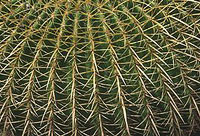 The pleated shape of the Barrel Cactus allows it to expand when it rains and store water in its spongy tissue. It shrinks in size during dry times as it uses the stored water.
The pleated shape of the Barrel Cactus allows it to expand when it rains and store water in its spongy tissue. It shrinks in size during dry times as it uses the stored water. 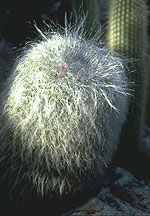 The white hairy surface of the Old Man Cactus helps the plant reflect the hot desert sun.
The white hairy surface of the Old Man Cactus helps the plant reflect the hot desert sun.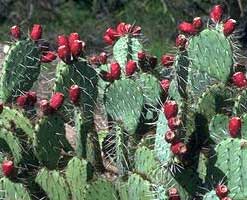 Since many desert plants store water in their spongy tissue, animals will eat them for the moisture. The thorns keep them safe from many animal predators. You can find lots of Prickly Pear Cactus in the Chihuahuan desert.
Since many desert plants store water in their spongy tissue, animals will eat them for the moisture. The thorns keep them safe from many animal predators. You can find lots of Prickly Pear Cactus in the Chihuahuan desert.
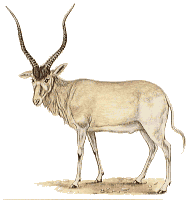
| Class: Mammalia: Mammals | Diet: Plants |
| Order: Artiodactyla: Even-toed Ungulates | |
| Size: body:1.3 m (4 1/4 ft), tail: 25 - 35 cm (9 3/4 - 13 3/4 in) | |
| Family: Bovidae: Bovids | Conservation Status: Critically endangered |
| Scientific Name: Addax nasomaculatus | Habitat: sandy and stony desert |
| Range: Africa: E. Mauritania, W. Mali; patchy distribution in Algeria, Chad, Niger and Sudan | |

| Class: Aves: Birds | Diet: Insects |
| Order: Passeriformes: Perching birds | |
| Size: body:18 - 22 cm (7 - 8 1/2 in) | |
| Family: Troglodytidae: Wrens | Conservation Status: Non-threatened |
| Scientific Name: Campylorhynchus brunneicapillus | Habitat: desert, arid scrubland |
| Range: Southwestern U.S.A. to central Mexico | |
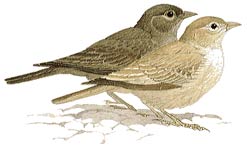
| Class: Aves: Birds | Diet: Seeds |
| Order: Passeriformes: Perching birds | |
| Size: body:15 cm (6 in) | |
| Family: Alaudidae: Larks | Conservation Status: Non-threatened |
| Scientific Name: Ammomanes deserti | Habitat: stony, hilly desert, dry wooded slopes |
| Range: Africa: Sahara; Middle East, through Iran to Afghanistan | |

| Class: Mammalia: Mammals | Diet: Large mammals |
| Order: Carnivora: Carnivores | |
| Size: body:about 1.5 m (5 ft), tail: about 35 cm (13 3/4 in) | |
| Family: Canidae: Dogs, Foxes | Conservation Status: Non-threatened |
| Scientific Name: Canis dingo | Habitat: sandy desert to wet and dry sclerophyll forest |
| Range: Australia | |

| Class: Mammalia: Mammals | Diet: Seeds, vegetation |
| Order: Rodentia: Rodents | |
| Size: body:14 - 18.5 cm (5 1/2 - 7 1/4 in), tail: 12 - 15 cm (4 3/4 - 6 in) | |
| Family: Gerbillinae: Gerbils | Conservation Status: Non-threatened |
| Scientific Name: Psammomys obesus | Habitat: sandy desert |
| Range: Algeria, east to Saudi Arabia | |
No comments:
Post a Comment